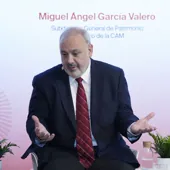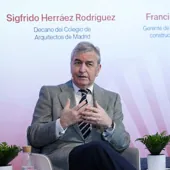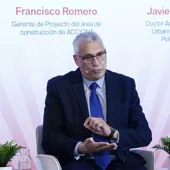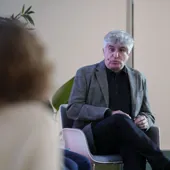On November 25, the Vocento-ABC headquarters hosted the meeting ‘Urban regeneration: challenges in the rehabilitation of unique buildings’, organized by ABC and Action and broadcast via streaming. It reflected on the state of protection of historic buildings in the midst of an era of urban evolution, to respond to the new needs of society. Regulations, innovation in its broadest sense and sustainability emerge as essential materials in times when a medium and long-term vision is required and, always, public-private collaboration to face with guarantees the delicate work in the BIC (Assets of Cultural Interest). ) and the BIP (Assets of Patrimonial Interest).
The experts summoned on this occasion were Miguel Ángel García Valero, deputy director general of Historical Heritage of the Community of Madrid; Sigfrido Herráez, dean of the Official College of Architects of Madrid; Francisco Romero, Project Manager of the construction area of ACCIONA and Javier Ruiz, doctor of architecture and professor of Urban Planning at the Polytechnic University of Madrid, with Mónica Arrizabalaga, editor of ABC, as moderator. Time and space to share contributions on the rehabilitation of historic buildings in the 20th century, under criteria of sustainability, accessibility, comfort, etc. Tradition and modernity, together under the umbrella of legislation that must be (as highlighted in the round table) “protective, driving, innovative.”
As García Valero highlighted, the rehabilitation of historic buildings does not imply a mere restoration “but the possibility of combining these criteria with the possibility of new uses, which means a new life for the buildings, both on the outside and inside.” And he highlighted the importance of the work of the commissions that ensure the correct performance of this activity: «In the Community of Madrid, special care and success has been demonstrated in these actions, with paradigmatic cases, such as in the case of hotels (in buildings that had not been conceived as such). Our mission is to respect the integrity of the heritage, we must ensure it.

«Restoration criteria must be combined with the possibility of new uses»
Angel Garcia Valero
Community of Madrid
Of social interest
In the case of Herráez, the objective of the commissions’ work “is not to penalize, but to guarantee that the technical requirements are met, in an action that is a social good, in public and private buildings. Heritage belongs to the entire society and, luckily, in the Community of Madrid we have laws and institutions that monitor compliance, in an environment in which the laws of the City Council, the Community, and the EU count.

«The objective of the commissions is not to penalize, but to guarantee that requirements are met»
Herráez highlighted examples such as those of the old Clesa Factory (project by Alejandro de la Sota), the wooden floor of the Maravillas gymnasium, the Huarte House, the Bishop’s Chapel in Madrid’s Plaza de la Paja, the stands of the La Hipódromo Zarzuela, etc. Initiatives in which the participants considered that their relevance reaches out, increasingly, to all ages and that continues, in the case of Madrid, with public competitions such as the one related to the Plaza del 2 de Mayo (59 projects presented) and the from the Plaza de Colón. It is part of a progress that was unthinkable years ago, as Herráez pointed out: “I did not imagine that the remains of the Arab Wall would be respected when reforming the portal of an urban property.”
Another aspect that the participants agreed on was the need for professionals, experts in the craft of construction and urban regeneration, even more so in specific tasks typical of a job that is partly artisanal. «Some ‘artisan’ trades in the construction sector are being lost that are very necessary for the rehabilitation of unique or historic buildings. We are clear that it is essential to incorporate innovations in materials and procedures to achieve good results in this type of work, but this has to go hand in hand with preserving traditional crafts and approaching the intervention with the sensitivity inherent to art restoration, in “which requires experience, open-mindedness and capacity for innovation,” warned Romero, with whom his colleagues agreed, who advocated recovering the Trade Schools as an essential step to be the leading country in the world in heritage conservation, a throne that we show off in everything the rest of the value chain of the restoration of historic buildings.

«Experience, open-mindedness and capacity for innovation are required»
Not only center
From the double role of teacher and practicing professional, Ruiz highlighted the responsibility of acting in the city “as before a living organism, before which this type of actions go beyond mere economic value. Each building is a world, and we must work on them with active, transformative protection, as has been done in the case of the Prado Museum for years, with interventions in rooms, stairs, etc. And he pointed out how the protection already reaches buildings from the 20th century, “and to the peripheries, which must be taken into account, not only the center of the capital”, in environments “in which it is necessary to take into account, in addition to sustainability, to universal accessibility.

«In addition to sustainability, universal accessibility must be taken into account»
Javier Ruiz
Polytechnic University of Madrid
As the participants in the forum stressed, involvement and collaboration are important… with cases in which it is not advisable for alarms to go off at the wrong time, as García Valero recalled: «In a hospitality business, a cobblestone floor had to be kept intact. 15th century, and what seemed like an imponderable became an attraction for the premises, protected by a glass floor. Attitude and the aforementioned aptitude to face everything that remains to be done in the 21st century with the historical legacy, with the footprint of what was built in other times and circumstances.
Innovation in sustainability, a fundamental part of the process
Another aspect highlighted in the meeting, as in the case of the Acciona representative, was that of sustainability, as a process and as a legacy (“in the company we have a very clear idea, and not just now, of how to think about the circular economy, in sustainability»).
Value applied in buildings in whose rehabilitation Acciona has participated, such as the Canfranc International Station, the Prado Museum and Ombú (rehabilitation project, with Foster + Partners, of an old gas plant from 1905 designed by the architect Luis de Landecho). And on the Acciona Campus itself.
In this context of knowledge and experience in favor of progress, technology helps to rehabilitate, to regenerate, so that these ‘new lives’ that were discussed in the forum are in line with the logical imperatives of sustainability, with the Sustainable Development Goals. stipulated by the UN and by European regulations in this regard.
Innovative uses of new, more sustainable materials, the incorporation of energy efficiency measures, new technologies such as robotics… Technology in times of circular economy, benefited by aspects such as the reduction of waste in an urban regeneration that generates, increasingly, new poles of economic and cultural development.
Everything adds up to the present of a future in which urban regeneration can count (as Sigfrido Herráez suggested), “with ‘neighborhood architects’, retired professionals, for example, who look after the heritage.”
#Keys #life #historic #buildings #21st #century


